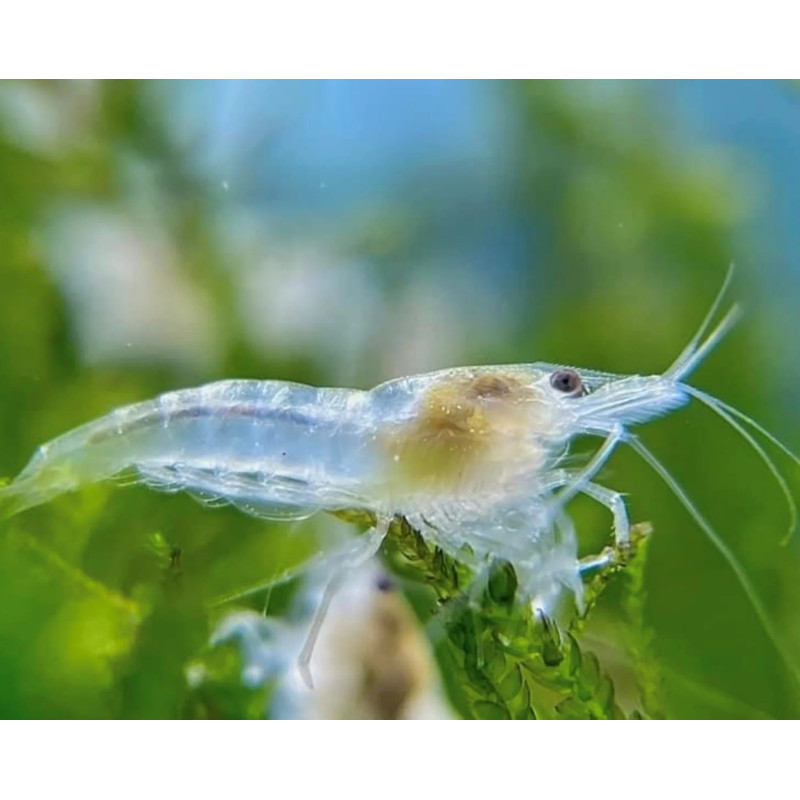Stocks Available
Sakura Shrimp
SKU:128144
NEOCARIDINA SP
0.25-1 INCH

Stock Available
Introduction: Species: Neocaridina cf. zhangjiajiensis Common Names: Snowball Shrimp, White Pearl Shrimp Natural Habitat: Native to freshwater streams and rivers in Taiwan, Snowball Shrimp thrive in clean, well-oxygenated waters with abundant plant life. Physical Characteristics: Appearance: The Snowball Shrimp is known for its striking white or translucent body, often adorned with small white spots or "snowballs" on its shell. The patterns can vary between individuals, with some exhibiting a more uniform coloration. Their bodies are relatively smooth, and they have distinct rostrums and antennae that contribute to their unique appearance. Size: Grows to about 1-1.5 inches (2.5-4 cm) in length. Lifespan: Typically lives for 1-2 years with proper care. Habitat Requirements: Tank Size: A minimum of 10 gallons is recommended for a small group; larger tanks are preferable to ensure stable water conditions. Water Conditions: Temperature: 68-78°F (20-26°C). pH: 6.0-7.5 (slightly acidic to neutral). Hardness: Soft to moderately hard water (3-8 dGH). Aquascaping: Create a well-planted aquarium with plenty of hiding spots using mosses, rocks, and driftwood. This setup will provide the shrimp with a safe environment to explore and retreat when needed. Diet: Primary Diet: Omnivorous; in their natural habitat, they feed on biofilm, algae, decaying plant matter, and small detritus. Supplemental Feeding: In captivity, offer high-quality shrimp pellets, blanched vegetables (such as zucchini and spinach), and algae wafers. Occasional protein sources, like spirulina powder or specialized shrimp foods, are recommended for balanced nutrition. Feeding Frequency: Feed small amounts daily, ensuring any leftover food is promptly removed to maintain water quality. Compatibility: Temperament: Generally peaceful and social; Snowball Shrimp do best in groups of 5 or more to exhibit natural behavior. Suitable Tank Mates: Compatible with other small, peaceful species like Neon Tetras, Rasboras, and small community fish. They can also coexist with other shrimp species, provided the tank mates are not aggressive. Incompatibilities: Avoid housing them with larger or aggressive fish that may prey on the shrimp, as well as fin-nipping species. Care Level: Difficulty: Easy; they are resilient and adaptable, making them suitable for both beginner and experienced aquarists. However, they require stable water parameters to thrive. Health Monitoring: Regularly check for signs of molting and ensure access to calcium-rich food sources to promote healthy shell development. Monitor water quality closely, as fluctuations can lead to stress and health issues. Breeding: Breeding in Captivity: Breeding is possible under suitable conditions, as Snowball Shrimp are prolific breeders. Spawning: Females carry fertilized eggs under their tails, which hatch into miniature shrimp after about 30 days. It's important to provide hiding spots for the young shrimp to protect them from potential predators. Economic Considerations: Market Demand: There is a high demand for Snowball Shrimp among shrimp enthusiasts due to their unique appearance and ease of care. Wholesale/Retail Pricing: Prices can vary based on color patterns and genetic traits, with certain individuals commanding a premium. Sustainability and Conservation: Wild Population: Not currently considered endangered, but habitat degradation can impact natural populations. Aquaculture Efforts: Increasingly bred in captivity to reduce reliance on wild populations and promote sustainable practices. Regulations: Follow local regulations regarding the trade of freshwater shrimp, as some regions may have restrictions on certain species. Conclusion: The Snowball Shrimp is a beautiful and engaging addition to freshwater aquariums. Their unique coloration and peaceful nature enhance the visual appeal of any tank while contributing to its overall health by grazing on algae and detritus. With moderate care requirements, Snowball Shrimp are suitable for both novice and experienced aquarists. With proper attention to their habitat and diet, these shrimp can thrive and add vibrant life to your aquarium.
Data sheet
16 other products in the same category:
Customers who bought this product also bought: